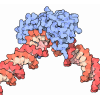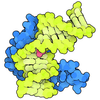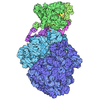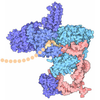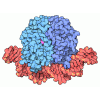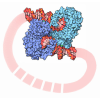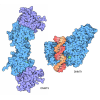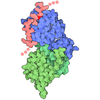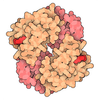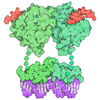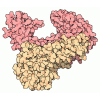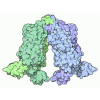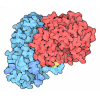[English] 日本語
 Yorodumi
Yorodumi- PDB-8zp5: Cryo-EM structure of origin recognition complex (Orc5 basic patch... -
+ Open data
Open data
- Basic information
Basic information
| Entry | Database: PDB / ID: 8zp5 | ||||||
|---|---|---|---|---|---|---|---|
| Title | Cryo-EM structure of origin recognition complex (Orc5 basic patch mutations) with ARS1 DNA bound | ||||||
 Components Components |
| ||||||
 Keywords Keywords | REPLICATION | ||||||
| Function / homology |  Function and homology information Function and homology informationCDC6 association with the ORC:origin complex / Cul8-RING ubiquitin ligase complex / maintenance of rDNA / Assembly of the ORC complex at the origin of replication / nuclear origin of replication recognition complex / pre-replicative complex assembly involved in nuclear cell cycle DNA replication / Activation of the pre-replicative complex / nuclear pre-replicative complex / Activation of ATR in response to replication stress / nucleosome organization ...CDC6 association with the ORC:origin complex / Cul8-RING ubiquitin ligase complex / maintenance of rDNA / Assembly of the ORC complex at the origin of replication / nuclear origin of replication recognition complex / pre-replicative complex assembly involved in nuclear cell cycle DNA replication / Activation of the pre-replicative complex / nuclear pre-replicative complex / Activation of ATR in response to replication stress / nucleosome organization / DNA replication preinitiation complex / mitotic DNA replication checkpoint signaling / silent mating-type cassette heterochromatin formation / Orc1 removal from chromatin / regulation of DNA replication / DNA replication origin binding / DNA replication initiation / subtelomeric heterochromatin formation / nucleosome binding / chromosome, telomeric region / chromatin binding / ATP hydrolysis activity / nucleoplasm / ATP binding / metal ion binding / nucleus Similarity search - Function | ||||||
| Biological species |   | ||||||
| Method | ELECTRON MICROSCOPY / single particle reconstruction / cryo EM / Resolution: 2.98 Å | ||||||
 Authors Authors | Lam, W.H. / Yu, D. / Dang, S. / Zhai, Y. | ||||||
| Funding support | 1items
| ||||||
 Citation Citation |  Journal: Proc Natl Acad Sci U S A / Year: 2025 Journal: Proc Natl Acad Sci U S A / Year: 2025Title: DNA bending mediated by ORC is essential for replication licensing in budding yeast. Authors: Wai Hei Lam / Daqi Yu / Qiongdan Zhang / Yuhan Lin / Ningning Li / Jian Li / Yue Wu / Yingyi Zhang / Ning Gao / Bik Kwoon Tye / Yuanliang Zhai / Shangyu Dang /   Abstract: In eukaryotes, the origin recognition complex (ORC) promotes the assembly of minichromosome maintenance 2 to 7 complexes into a head-to-head double hexamer at origin DNA in a process known as ...In eukaryotes, the origin recognition complex (ORC) promotes the assembly of minichromosome maintenance 2 to 7 complexes into a head-to-head double hexamer at origin DNA in a process known as replication licensing. In this study, we present a series of cryoelectron microscopy structures of yeast ORC mutants in complex with origin DNA. We show that Orc6, the smallest subunit of ORC, utilizes its transcription factor II B-B domain to orchestrate the sequential binding of ORC to origin DNA. In addition, Orc6 plays the role of a scaffold by stabilizing the basic patch (BP) of Orc5 for ORC to capture and bend origin DNA. Importantly, disrupting DNA bending through mutating three key residues in Orc5-BP impairs ORC's ability to promote replication initiation at two points during the pre-RC assembly process. This study dissects the multifaceted role of Orc6 in orchestrating ORC's activities on DNA and underscores the vital role of DNA bending by ORC in replication licensing. | ||||||
| History |
|
- Structure visualization
Structure visualization
| Structure viewer | Molecule:  Molmil Molmil Jmol/JSmol Jmol/JSmol |
|---|
- Downloads & links
Downloads & links
- Download
Download
| PDBx/mmCIF format |  8zp5.cif.gz 8zp5.cif.gz | 510.2 KB | Display |  PDBx/mmCIF format PDBx/mmCIF format |
|---|---|---|---|---|
| PDB format |  pdb8zp5.ent.gz pdb8zp5.ent.gz | 392.4 KB | Display |  PDB format PDB format |
| PDBx/mmJSON format |  8zp5.json.gz 8zp5.json.gz | Tree view |  PDBx/mmJSON format PDBx/mmJSON format | |
| Others |  Other downloads Other downloads |
-Validation report
| Summary document |  8zp5_validation.pdf.gz 8zp5_validation.pdf.gz | 1.6 MB | Display |  wwPDB validaton report wwPDB validaton report |
|---|---|---|---|---|
| Full document |  8zp5_full_validation.pdf.gz 8zp5_full_validation.pdf.gz | 1.6 MB | Display | |
| Data in XML |  8zp5_validation.xml.gz 8zp5_validation.xml.gz | 77.2 KB | Display | |
| Data in CIF |  8zp5_validation.cif.gz 8zp5_validation.cif.gz | 117.9 KB | Display | |
| Arichive directory |  https://data.pdbj.org/pub/pdb/validation_reports/zp/8zp5 https://data.pdbj.org/pub/pdb/validation_reports/zp/8zp5 ftp://data.pdbj.org/pub/pdb/validation_reports/zp/8zp5 ftp://data.pdbj.org/pub/pdb/validation_reports/zp/8zp5 | HTTPS FTP |
-Related structure data
| Related structure data |  60327MC 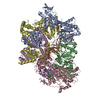 8zp4C  8zpkC M: map data used to model this data C: citing same article ( |
|---|---|
| Similar structure data | Similarity search - Function & homology  F&H Search F&H Search |
- Links
Links
- Assembly
Assembly
| Deposited unit | 
|
|---|---|
| 1 |
|
- Components
Components
-Origin recognition complex subunit ... , 6 types, 6 molecules BEFACD
| #1: Protein | Mass: 71342.180 Da / Num. of mol.: 1 Source method: isolated from a genetically manipulated source Source: (gene. exp.)   |
|---|---|
| #2: Protein | Mass: 55116.832 Da / Num. of mol.: 1 / Mutation: R360A, R366A, K367A Source method: isolated from a genetically manipulated source Source: (gene. exp.)   |
| #3: Protein | Mass: 50369.531 Da / Num. of mol.: 1 Source method: isolated from a genetically manipulated source Source: (gene. exp.)   |
| #6: Protein | Mass: 104546.164 Da / Num. of mol.: 1 Source method: isolated from a genetically manipulated source Source: (gene. exp.)   |
| #7: Protein | Mass: 72161.766 Da / Num. of mol.: 1 Source method: isolated from a genetically manipulated source Source: (gene. exp.)   |
| #8: Protein | Mass: 60772.152 Da / Num. of mol.: 1 Source method: isolated from a genetically manipulated source Source: (gene. exp.)   |
-DNA chain , 2 types, 2 molecules GH
| #4: DNA chain | Mass: 23708.256 Da / Num. of mol.: 1 / Source method: obtained synthetically / Source: (synth.)  |
|---|---|
| #5: DNA chain | Mass: 23766.305 Da / Num. of mol.: 1 / Source method: obtained synthetically / Source: (synth.)  |
-Non-polymers , 2 types, 6 molecules 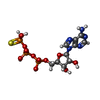


| #9: Chemical | | #10: Chemical | |
|---|
-Details
| Has ligand of interest | Y |
|---|---|
| Has protein modification | N |
-Experimental details
-Experiment
| Experiment | Method: ELECTRON MICROSCOPY |
|---|---|
| EM experiment | Aggregation state: PARTICLE / 3D reconstruction method: single particle reconstruction |
- Sample preparation
Sample preparation
| Component | Name: Origin recognition complex with Orc5 basic patch mutation, in complex with ARS1 DNA Type: COMPLEX / Entity ID: #1-#8 / Source: RECOMBINANT | |||||||||||||||||||||||||
|---|---|---|---|---|---|---|---|---|---|---|---|---|---|---|---|---|---|---|---|---|---|---|---|---|---|---|
| Molecular weight | Value: 0.42 MDa / Experimental value: YES | |||||||||||||||||||||||||
| Source (natural) | Organism:  | |||||||||||||||||||||||||
| Source (recombinant) | Organism:  | |||||||||||||||||||||||||
| Buffer solution | pH: 7.5 | |||||||||||||||||||||||||
| Buffer component |
| |||||||||||||||||||||||||
| Specimen | Embedding applied: NO / Shadowing applied: NO / Staining applied: NO / Vitrification applied: YES | |||||||||||||||||||||||||
| Specimen support | Grid material: GOLD / Grid type: C-flat-1.2/1.3 | |||||||||||||||||||||||||
| Vitrification | Cryogen name: ETHANE |
- Electron microscopy imaging
Electron microscopy imaging
| Experimental equipment |  Model: Titan Krios / Image courtesy: FEI Company |
|---|---|
| Microscopy | Model: FEI TITAN KRIOS |
| Electron gun | Electron source:  FIELD EMISSION GUN / Accelerating voltage: 300 kV / Illumination mode: FLOOD BEAM FIELD EMISSION GUN / Accelerating voltage: 300 kV / Illumination mode: FLOOD BEAM |
| Electron lens | Mode: BRIGHT FIELD / Nominal magnification: 81000 X / Calibrated magnification: 47170 X / Nominal defocus max: 2500 nm / Nominal defocus min: 1000 nm / Calibrated defocus min: 1000 nm / Calibrated defocus max: 2500 nm / Cs: 2.7 mm / C2 aperture diameter: 100 µm / Alignment procedure: COMA FREE |
| Specimen holder | Cryogen: NITROGEN / Specimen holder model: FEI TITAN KRIOS AUTOGRID HOLDER |
| Image recording | Electron dose: 50 e/Å2 / Film or detector model: GATAN K3 BIOQUANTUM (6k x 4k) |
- Processing
Processing
| EM software |
| ||||||||||||||||||||||||||||||||||||||||
|---|---|---|---|---|---|---|---|---|---|---|---|---|---|---|---|---|---|---|---|---|---|---|---|---|---|---|---|---|---|---|---|---|---|---|---|---|---|---|---|---|---|
| CTF correction | Type: PHASE FLIPPING AND AMPLITUDE CORRECTION | ||||||||||||||||||||||||||||||||||||||||
| Particle selection | Num. of particles selected: 1387713 | ||||||||||||||||||||||||||||||||||||||||
| Symmetry | Point symmetry: C1 (asymmetric) | ||||||||||||||||||||||||||||||||||||||||
| 3D reconstruction | Resolution: 2.98 Å / Resolution method: FSC 0.143 CUT-OFF / Num. of particles: 191281 / Algorithm: BACK PROJECTION / Num. of class averages: 1 / Symmetry type: POINT | ||||||||||||||||||||||||||||||||||||||||
| Atomic model building | Protocol: RIGID BODY FIT | ||||||||||||||||||||||||||||||||||||||||
| Refinement | Highest resolution: 2.98 Å |
 Movie
Movie Controller
Controller




 PDBj
PDBj